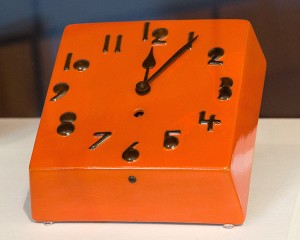
Clock, designed by Greta Heimann-Loebenstein.
Gift from the heirs of Greta Heimann-Loebenstein.
© Jewish Museum Berlin, photo: Nadja Rentzsch
“I chose this clock,” says Leonie* (8 years old) pointing to the showcase. The clock is red and the numbers look a bit strange. She laughs. “A clay clock!” She’s never seen anything like it. The children study the cups, pots, and vases in the big cabinet intently. They gaze, curiously, at the shapes, colors, and designs. They’re supposed to pick the object they like best. Then they’ll learn the name of the ceramicist who made it, its purpose and appearance.
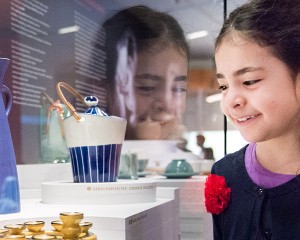
Children’s tour through the cabinet exhibition “Tonalities. Jewish Women Ceramicists from Germany after 1933”
© Jewish Museum Berlin, photo: Nadja Rentzsch
Jona (7) exclaims: “I like this bowl best. Grete made it.” “I think that design is lovely. What would you put in the bowl?” Anna (43) asks him.
Anna is guiding the children from a Berlin elementary school through the cabinet exhibition “Tonalities. Jewish Women Ceramicists from Germany after 1933.” Without hesitating, Jona answers: “Apples or bananas, or even nuts.” “Maybe even pears, or bread!” calls out Elsa (8).
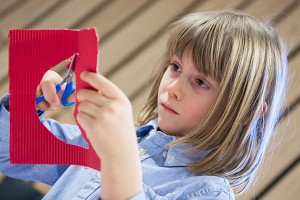
Workshop at the studio in the Academy of the Jewish Museum Berlin
© Jewish Museum Berlin, photo: Nadja Rentzsch
Her favorite object is a candlestick. It’s beige and was made by the ceramicist Hanna. Anna asks the class, “Do you all know what celebration this candlestick would be used for?” Leonie’s hand flies up; she knows the answer: Hanukkah. She has just participated in a candle-dipping workshop for the Jewish Festival of Lights in December.
After the tour, the children start working on their own projects. → continue reading
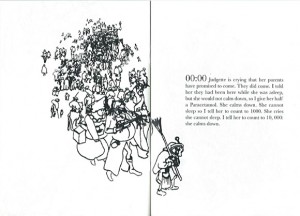
Excerpt from “The Guardian / Sycamore Group”
© Atalya Laufer
One of the works in our art vending machine is a booklet which provides an insight into the inner-workings of many of the Israeli Kibbuzim. With sober drawings and a text that is based on archival documents, artist Atalya Laufer (b. 1979) exposes a particular aspect of growing up on a Kibbutz. As one of the last generation of children to be raised in communal children’s houses (Batei Yeladim), she takes us on a journey through time and into the passing world of the Kibutzim.
The text in the booklet is based on protocols of night shifts that were taken in the early 1970s. In these protocols incidents and particularities in every house, during every night shift, had been recorded. Owing to these we can readily reconstruct the daily life in children’s houses. → continue reading
An Appeal for Recognition and Dignity
“We used to throw stones at her – we thought she was a witch.” With these words, a former resident of Rishon LeZion ruefully told me of her childhood encounters with the sculptor and doll maker, Edith Samuel. Edith wore her long, dark, European skirts under the searing Middle Eastern sun and suffered from a physical deformity. The daughter of a liberal German rabbi, Edith and her sister Eva were both artists who left their home city of Essen in the 1930s and immigrated to Palestine.
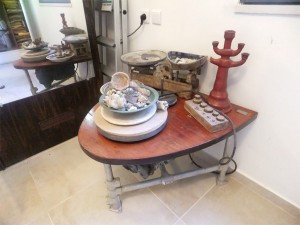
The pottery wheel belonging to Paula Ahronson, Eva Samuel’s business partner, is preserved in private hands and untouched since her death in 1998
© Jewish Museum Berlin, photo: Michal Friedlander
The Samuel sisters worked long hours, struggled to earn a living and did not gain the recognition that they deserved, during their lifetimes. The exhibition “Tonalities” at the Jewish Museum Berlin aims to bring forgotten women artists back into the public arena. It presents Eva Samuel’s works and that of other women ceramicists who were forced to leave Germany after 1933.
My search for transplanted German, Jewish women in the applied arts began many years prior to my encounter with the Samuel sisters. It was Emmy Roth who first captured my attention. Born in 1885, Roth was an exceptionally talented and internationally successful silversmith, who worked in Berlin. She immigrated to Palestine and fell into obscurity, ultimately taking her own life in 1942. Her male refugee colleagues, Ludwig Wolpert and David Gumbel, were appointed to teach metalwork at the Jerusalem New Bezalel School of Art in the late 1930s. They are feted in Israel today, whereas Roth is still completely unknown there. → continue reading




